A spanish lady give us some advices to remove stains
Tuesday, June 30, 2015
I have just found a video, with some interesting advices for your home. If you want to watch this video, please click on the link below:
http://www.rtve.es/alacarta/videos/la-manana/consejos-maxi-limones-hogar/3185239/
Maxi: “What curiosities have we today for all those little things, that you are asking me? ... I am going to start to make you an air freshener summer ... and, above all, to those houses, which we are going to open now and which smell a little bit closed; you will see how simple .... We are going to put water ... so, as a…..what you calculate ...; we are going to put rosemary, rosemary plant, --that about rosemary you can write a whole book--, to this we will add 2 teaspoons cinnamon .....- Ay what a look it has….and what a nice it is…..!; and you will see what we are going to do ...--; and, also, we are going to put lemon…...-- my lemon, my lemon tree ...--, how I like lemon ..!,. .. really, I am passionate and also you will see how many tricks we have with a lemon .... This thing, so precious, we are going to boil and we are going to leave it, there, all the time, until it is going to consume, it is consumed ...; but you do not know what smell is in the whole house ... ; you are going to get away that smelly closed house ...; therefore, I have entitled it "Scent of Summer"; but you can do it, when you want ...... Well, we are going for another thing ....... I found this great .... you do not know how rich it smells ...?, without boiling and it smells well ..., so, imagine when you go to put it on fire .... Now, I am going to make you another thing, that you are asking me a lot: you tell me how to remove the stains or scratches --or as you want— by the pen, when we stain a shirt, a sweatshirt, with the ink of the pen ...; but very simple, you will see how easy it is .... My lemon lover, again ... well .... You have a line marker, and going to do the part where the sleeve is, the shirt, the pants, and going to moisten, then with lemon juice ..... and you are going to rub ...; Well, you see how it goes, Do not you? ... look ... how simple ... and see you...?; Well, once, you rub it a little bit, it is almost not necessary, you put it into the washer and….. goodbye to the pen, on our shirts and our clothes ... The lemon, …..how important!. Huh !.... ..... oh the lemon, therefore I say that it is my lover .....!. I have so many things ...; but still I get more .....There I go……….Now, I have a beautiful thing. Because you are asking me much, in white tablecloths, in napkins, on t-shirts, when your sweat goes out, there is no way to remove it ...... or, for example, I should have something ... .Do you see which tones so different ...? : here it is the pure white and yellow stays here ..., this is what we are going to solve now .... and we are going to take a pan, you put water, as I have made here, and we are going to add a handful of salt ...... , be splendid, as I always say, and, you see, all at home in our kitchen; therefore, you will see how well it works and clothes are not going to spoil; ie, water and salt. And now, we are going to put the piece that you have ...t- shirt or white napkins… --that tablecloths of Christmas, that, from one year to another, they go out some yellow spots, which long story, ....... I know ... I know that problem exists there and you ask me a lot about it--...; you have seen .. moreover you will see how nice ... Now, we put the piece and, above, we are going to put ... everything, everything full, covered with lemons ... there ...; cover the entire piece, that you are going to put, whole .... it is better that you go too far and that is the whole piece, covered with slices of lemons ... that you put it to boil, you leave it 10 minutes, not very high heat, but gradually, as the pots before ... cluck cluck cluck, little by little, as the beans, to be boiling, then slowly; 10 minutes so you leave it ..., then stick out your piece, you put it into your usual washing machine .... and you already will tell me ......”
Well, I hope that you have liked these advices.
Until my next post, kind regards,
Luis.
Sponsored by Costaluz Lawyers.
Please click below:

 0
Like
Published at 11:16 AM Comments (0)
0
Like
Published at 11:16 AM Comments (0)
A great discovery relating to vegetables in Spain
Friday, June 26, 2015
Some days ago, I could listened on the radio a very curious news and I have just found the same news, that says the following: “They show that fried vegetables with olive oil are healthier than cooked”.
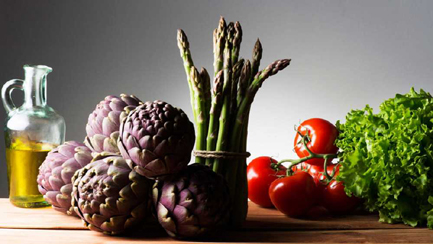
Researchers, at the University of Granada (UGR), have shown that fried vegetables, with olive oil, improve antioxidant capacity and the content of phenolic compounds, which prevent chronic degenerative diseases such as cancer, diabetes or macular degeneration.
In an article, published in the journal Food Chemistry, the scientists have found that frying, in extra virgin olive oil (EVOO), is the cooking technique that more increases the phenolic fraction of fresh vegetables, included in the Mediterranean diet.
That is, foods such as potatoes, squash, tomatoes and eggplant improve, in the cooking process.
 .jpg)
 - Copy 4.jpg) .jpg)
To conduct the study, the researchers designed an experiment, in which they cooked portions of 120 grams of potato cubes (Solanumtuberosum), pumpkin (Cucurbitamoschata), tomato (Licopersicumesculentum) and eggplant (Solanummelongena), without seeds and skin.
Thus, they fried and skipped the vegetables with oil and also they boiled them, in water or a mixture of water and AOVE. They controlled experiments to ensure all processing conditions, and the ratio, between the plant and the means of cooking, was remained constant, according to traditional Spanish recipes.
Processed vegetables were maintained under conditions suitable for the determination of moisture, fat, dry matter and total phenols, and the measure of antioxidant capacity by different methods.
Alongside, the study was completed with the determination, by High Performance Liquid Chromatography (HPLC, for its acronym in English) of the content of individual phenolic compounds, characteristic of vegetables.
The results showed that the use of AOVE, during frying of vegetables, increases their fat content and reduces its moisture, while in the rest of techniques, this effect is not observed.
"By comparing the total phenolic content, compared to fresh vegetables, we found both increases and decreases, according to the applied technique", explained one of the authors of this work, the teacher at UGR, Cristina Sanchez Samaniego.
"Oil, as heat means transfer, increases the content of phenolic compounds in vegetables, compared with other cooking techniques, such as boiling, where heat transfer occurs across the water", she says.
This is due to that a transfer occurs, from phenols AOVE to vegetables, these enriched, with phenolic compounds, exclusive of oil, which are not naturally present in fresh vegetables.
"Therefore, we can say that frying is the technique, that produces higher associated increases, in phenolic fraction, representing an improvement, in the cooking process, although it increases the caloric density of food, because of the amount of oil absorbed" , emphasizes Samaniego.
All cooking techniques increased the antioxidant capacity of the four vegetables; there were only reduced or no significant changes, after cooking, in water, in specific cases.
The researcher, at the UGR, points out that, each vegetable cooked, developed a profile of phenols, moisture content, fat, dry matter and antioxidant activity, determined by the original characteristics of fresh vegetables and cooking technique applied.
"When the phenol content of raw vegetable is high, the total phenolic content is further increased, if AOVE is included, during processing and the application of treatments boiled does not affect the final concentrations", said Samaniego.
"The cooking method, including water, may be recommended, when food is consumed along with the means of boiling, and adding AOVE improves phenolic profile and compensates for deficiencies, in raw foods", says the researcher.
The results of this article are part of the doctoral thesis of Jessica del Pilar Ramirez Anaya, made under the direction of the teachers, at the UGR, Cristina Sanchez Samaniego, Marina Villalón Mir and Herminia López-García de la Serrana, in the Department of Nutrition and Food Science, at the Faculty of Pharmacy, at the University of Granada, and with the support of PROMEP / SEP, Mexico UDG-598, program.
Well, once again, some Spanish researchers are at the head of the international medical research. I hope that you have found this news very interesting.
Until my next post, kind regards,
Luis.
Sponsored by Costaluz Lawyers.
Please click below:

 0
Like
Published at 9:58 PM Comments (0)
0
Like
Published at 9:58 PM Comments (0)
The Terrae Network in Spain
Thursday, June 25, 2015
I have just found an interesting video, about land in Spain. If you want to watch this video, please click on the link below:
http://www.rtve.es/alacarta/videos/agrosfera/agr-primer-plano-red-terrae/3170227/
On the image, you can read: Terrae Network. Rent, to be trained and undertake.
Voice in off: “Prevent that agricultural activity and municipalities continue to lose population is the goal of the Terrae Network (an initiative that leaves from the creation of a land bank, through Internet, to facilitate contact between those who offer a rental and those who require it, always for agroecological crops”.
Mila Martín García (Technical Secretary of the Network Terrae): “The first step, that we had to give, was to revive the lands, that were in disuse, not cultivated, turn a little bit the agricultural landscape and ... we create the online tool: Bank land”
Manuel Redondo (Responsible of Comunication of the Terrae Network): ”It is freely available, everyone can come and register itself, through the web: www.tierrasagroecologicas.es. Enter the Land Bank, put your contact details and, somehow, you offer or demand”.
Voice in off: “Maximiliano has rented two lands, through the Network: an orchard and a vineyard, and he has been installed with his family, in Redueña (Madrid). By the moment, the production is for own consumption”.
Maximiliano Caripá (farmer): “Short-term and mid-term, it would be like a workplace; having a group of people, in Madrid or near developments of Redueña, who buy us the product”
Maria de las Mercedes Pérez González (Mayor of Redueña, Madrid): “With this project, what we do is re-boost, a little, our natural environment, which is our full potential”
Voice in off: “Beyond reclaim land and rural environment, the objectives of the network also pass by offer training, whom want to learn to cultivate, for subsistence or to create a small business. Carcaboso, in Caceres, is one of the municipalities, that more has developed this kind of theoretical and practical training”.
Elena Arroyo (Trainee instructor of organic farming): “We have made a compo of quality, to improve soil fertility; we have done the terraces, to improve water draining; we have installed irrigation; we made the seed; we have planted; ……well, all phases of a crop of deployments, from start to finish; and where we are doing tests and trials of varieties, management….”
Note: While Elena was talking about the compo, the terraces and so on, you could see the word “Calabacines” (“Courgettes”), on yellow colour.
Voice in off: “Roberto has launched this small cannery; but before, when he was unemployed, he learned to cultivate, in the social garden of the Hall: he planted and sold his vegetables to private citizens and shops, in the area”
Roberto Clemente (Resident of Carcaboso): “Here, there was a restaurant, that served food and every day, it had, on the menu, a dish of First and Second dish, of zero kilometer, which was here in the area; then we were serving him vegetables and green vegetables ....”
Voice in off: “Also, in Carcaboso, the city hall has launched other initiatives: these edible gardens replace, in the town streets, to the simply ornamental ones”
Lorena Rodríguez Lucero (Mayor of Carcaboso, Cáceres): “You can find, in our gardens, lettuce, onion, tomato, pepper ...., depending on the season ... It has been like a community objective: to see that what we grow in the village, it is for everyone --If you are making the food and you forget the lettuce, onion or pennyroyal, you can come and diging it—“.
Voice in off: “The idea of transforming the ornamental gardens, to edible, born in Great Britain, with the INCREDIBLE EDIBLE movement, and imported by TERRAE NETWORK; also, it serves to encourage the participation of residents”.
A woman, resident of Redueña: “It had to be moved earth and having thrown some mulch and water ...”
Voice in off: “This former livestock trail of Redueña has become an arboretum (a botanical garden,with fruits, vegetables, flowers and aromatic plants, able to be visited and edible”.
Another woman, resident of Redueña: “Everything can be eaten,… yes, son, yes…”
A woman, resident of Redueña: “At the time of collards, you plant cabbage, you plant Lombardy…”
A third woman, resident of Redueña: “Yes, so we come for a while and….well, we have a good time……”
Another woman, resident of Redueña: “The men tell us not to, who have worked hard and who do not want this one”
Mila Martín García: “We work with seniors --whom we call "Agricultos”, who are all people who have the traditional knowledge of the culture and development of the land and they are the ones, who are giving us the knowledge, that we are linking a little bit to the project”
Voice in off: “For residents, and with the work of the residents, it is also this community henhouse; seven families, like Ignacio one, care for it, each one day, a week”
Ignacio López García (Resident of Redueña): “Feed them and bring the organic remains of some residents, who collaborate with the feeding of chickens, to be all fairly natural. The eggs are taken, every day, by the person who is its turn to care the henhouse, have 4 or 5, which there are, for own consumption”
Voice in off: “The network is present in 40 municipalities, in 8 autonomous regions, figures that they hope to expand soon. Between its projects is, in addition, direct offer of products, through Internet”
Well, I think this project is so interesting, because it provides some new ideas, thinking to help people. I hope that you have liked this video too.
Until my next post, kind regards,
Luis.
Sponsored by Costaluz Lawyers.
Please click below:

 0
Like
Published at 11:46 AM Comments (0)
0
Like
Published at 11:46 AM Comments (0)
A Spanish researcher has discovered two molecules, present in plants, which can reduce body fat
Saturday, June 20, 2015
Some days ago I found a very interesting news, that said: “Two molecules present in plant foods can reduce body fat”.
The Resveratrol and the Quercetin, two molecules, naturally present in many foods and beverages from plants such as grapes, wine, onion or apple, have shown, between other beneficial health effects, some ability to reduce body fat.
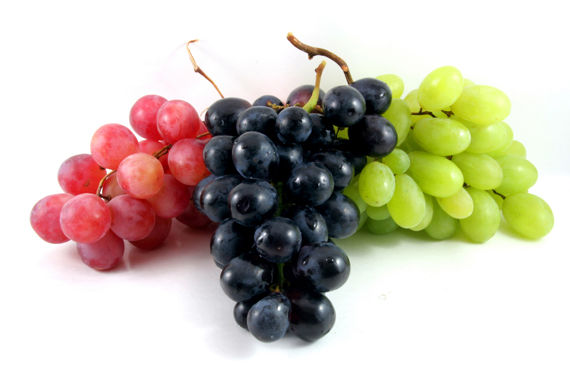
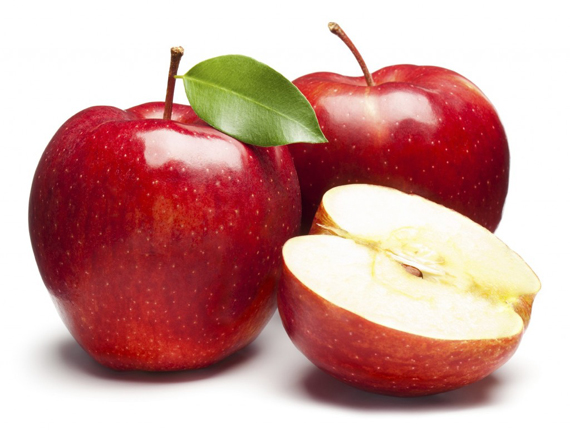
So it has been shown by the researcher, Noemi Arias, from the Nutrition and Obesity group, at the University of the Basque Country (UPV), in her doctoral thesis entitled 'Effects of the combination of biomolecules in food, conjugated linoleic acid, resveratrol and quercetin on the body fat accumulation'.
In work, carried out during the thesis, the doctor with distinction cum laude, watched the administration of a combination of these two compounds induces an effect, known as 'marronización' (to become brown colour) of the white adipose tissue, in a group of rats, fed with an obesogenic diet (rich in fat and sugar).
This effect, in addition to other observed in this experiment, could justify and help reduce weight and body fat, observed in this group of rats, reported by the UPV in a note.
Brown adipose tissue is a fatty tissue, that until not long ago was thought to be only present in newborn children and hibernating animals.
This tissue is responsible for dissipating the energy, as heat to maintain body temperature, instead of storing it, as with white adipose tissue, a process known as 'thermogenesis'.
Its recent discovery, also in the adult human being, and the inverse correlation between the amount of that tissue and less body mass index, has attracted interest from the scientific community by it.
The 'marronización' is a recent discovery process, that involves the development of adipocytes (or fat cells) with characteristics of brown adipocytes within white adipose tissue (called 'beige' or 'brite' adipocytes), and the activation of this process could help reduce body fat.
The marronizante effect, of this blend of resveratrol and quercetin, was first discovered by the research group to which it belongs, Noemi Arias, thanks to the collaboration of the University of the Balearic Islands, which allowed patent it.
Much of this research, which was funded by a project of the National Plan of the Ministry of Economy and Competitiveness, and has been published in international scientific journals and has led to a national patent, published in the Official Bulletin of Industrial Property, in March 2015.
Well, once again, a very interesting project has been developed by several Spanish researchers. I hope that you have liked it.
Until my next post, kind regards,
Luis.
Sponsored by Costaluz Lawyers.
Please click below:

 1
Like
Published at 11:52 PM Comments (0)
1
Like
Published at 11:52 PM Comments (0)
A Spanish music with legend
Wednesday, June 17, 2015
Several days ago, I listened, on the radio, a piece of Operetta,”La leyenda del beso” ("The legend of the kiss"), composed by the Spanish Reveriano Soutullo and Juan Vert.
Reveriano Soutullo (1880-1932) was born in Redondela (Pontevedra, Galicia). He had the musical close, from child, because his father was the Director of the band of music.
At the age of 19, he went to study to the Conservatoire of Madrid. While, he made a living playing the little cornet. He managed to enter The First Course of Harmony. He studied 3 years Harmony and Composition (subject in which they gave him the Extraordinary Prize).
Among 1906 and 1907, he returned to Vigo (Pontevedra, Galicia), where they gave him a scholarship, to study music abroad. Thanks to it he entered in touch with Italian or German musicians; but the musicians, who more marked him, were found by him in Paris: Debussy and Ravel.
Reveriano came back to Madrid, where he started composing operetta. He composed several famous operettas, between them: “Amores de aldea” (“Loves of village”).
Between 1919 and 1931 he formed a famous tandem with Juan Vert, with whom he composed big successes like: “La leyenda del beso”, “El ultimo romantico”, “La del Soto del Parral”………..
Reveriano died in 1932, because of a complication in the postoperatory of an operation of ear. But, the presenter of the program on the radio, that I listened, said that he could not overcome the death of his companion and firend, Juan Vert, who died in 1931.
Juan Vert Carbonell (1890-1931). He was born in Carcaixent; but, when he was few months old, his family went from Carcaixent to Onteniente. He was introduced in Music by his father. In Onteniente (Valencia, East of Spain), he started his studies of music by Enrique Casanova (Director of the local band and Organist of the church of the Asuncion of Holy Maria).
A few years later he continued the courses of piano, harmony and composition, with Manuel Ferrando, in the College Concepcion, where he also studied Baccalaureate.
At the age of 14, he already was dominating the violin and the piano. In 1908, when Ferrando, his teacher, died, Juan was registered in the Conservatoire of Valencia, where the master, Emilio Vega --with whom Juan supported a great friendship, later-- succeeded the lyric inclination of his pupil.
In 1911, Juan went to Madrid and he studied at the Royal Top Conservatoire of Music, where he obtained the Honor's Prize in Harmony and Composition.
The city of Onteniente realized several tributes to Vert.
The Valencian Company of the Theatre Ruzafa represented "The legend of the kiss" under Ramon Sancho's direction, in which Vert agreed to direct free numbers. The own composer wrote a letter, to the Mayor of Onteniente, Manuel Mompó, in 1928, in which Vert said the following: "The press of Madrid and Valencia has dealt, with many extension, of the tribute and my good friends of here take part impassioned of my emotion and gratefulness".
In 1931, Juan Vert died suddenly, while he was writing “La maja serrana”.
The presenter of the radio program, where I listened “The legend of the kiss”, said that Reveriano Soutullo died just only one year later than his friend, Juan Vert, because of the pity caused by that death.
Now, I shoul like to share with you the work “The legend of the kiss”. If you want to watch the video, please click on the link below:
https://www.youtube.com/watch?v=TB4tg-ZDMc4
I knew that work, since many years ago; but I did not know that it has something to do with a modern spanish song, singed by the famous group MOCEDADES; now, they are named THE CONSORTIUM. The song is tittled “Amor de hombre” (“Love by a man”) and, if you want to listen it, please click below:
https://www.youtube.com/watch?v=1eIJXS1j_Js
This is a fragment of “The legend of the kiss”. I hope that you have liked everything.
Until my next post, kind regards,
Luis.
Sponsored by Costaluz Lawyers.
Please click below:

 0
Like
Published at 11:21 AM Comments (0)
0
Like
Published at 11:21 AM Comments (0)
Some Spanish scientists open the door for a new treatment against cancer
Friday, June 12, 2015
A study carried out by Sarrià's Chemical Institute (IQS) has opened the door to being able to diagnose and treat cancer, with infrared light. The study, that has been published in the magazine cover of the magazine “Chemical Communications”, of the Royal Society of Chemistry of London, there has been realized by the teacher of Physical Chemistry of the IQS, Santi Nonell, the expert in organic synthesis, Thibault Gallavardin, and the investigative PhD student of the IQS, Oriol Planas.
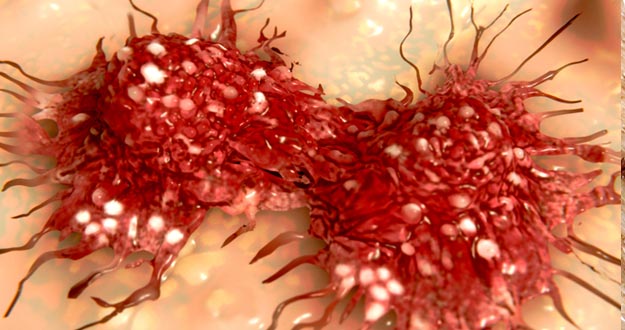
A cell of cancer being divided
The study, developed by the Laboratory of Photochemical of IQS, has discovered a new chemical reaction, in which a fluorescent probe changes color when it joins an antibody and other biomolecules of medical interest, as well as to a wide range of nanoparticles.
As has reported the IQS, scientific university of the Jesuits, the marking antibody, biomolecules and nanoparticles, with fluorescent probes, it is a technique that is in use, in clinical tests and in diagnosis for image.
Recently also it is started using for guiding surgical interventions, in real time; but one of the principal problems of the probes, nowadays, available is that its emissionis, in the visible zone of the spectrum, and is overlapped by the typical autofluorescence of the biological fabrics.
However, the fluorogenic probes, developed in the IQS, solve this problem, due to the fact that the change of color allows to separate the probes, joined the antibody, those who could have been separated.
On the other hand, its emission takes place in the zone of the infrared nearby one, a fact that fills an emptiness, nowadays existing in this zone of the spectrum.
Besides its fluorescent properties, the probes, joined the antibody, can be activated by light, to generate some reactivate forms of oxygen and hostesses induce the death of the cells, with high selectivity and efficiency, it has been explained by the IQS.
"This double diagnostic and therapeutic slope they awards a high potential as agents teranóstics for fotoimmunotherapy", have indicated the researchers.
Well, I think it is very interesting for any therapy. I hope that you have liked this news.
Until my next post, kind regards,
Luis.
Sponsored by Costaluz Lawyers.
Please click below:

 0
Like
Published at 9:55 PM Comments (0)
0
Like
Published at 9:55 PM Comments (0)
The impressive capture of the Tuna from Almadraba, in the South of Spain
Monday, June 8, 2015
I do not know if you remember that last May 14, 2013, I published a post, tittled: "The Levantá" in Andalusia (Spain). But, anyway, I should like to show you an impressive video about “The Levantá", ie how fishermen from Zahara de los Atunes capture the Red Tuna from Almadraba.
If you want to watch this video, please click below:
http://www.rtve.es/alacarta/videos/aqui-la-tierra/almadraba-alt/3145397/
A first fisherman (he seems to be the responsible): “Come on, come on…., come on to take it….!!! .....Come on……You have put it too much to here…….Why did you have put that boat such to here….with a tide that runs I tell you!.....Ahhhh, come on….on the aerly morning…., this is very early for us…. “
The Captain´s assistant: “Yes, now the fish is going into the tunny nets, which is where we are interested in it, to be able to catch it; the only part of the Tunny fishery, which has bottom. One of the ranas (divers), who are down, he sticks the pull and they already give the voice up, in order that everybody raise the "Carabera" ("Hawser") ...; now, everything has to be quite coordinated”
Note: “Rana” is a diver, because he is wearing some flippers, similar than frog legs.
A second fisherman: “Right now, the divers are down, waiting for the tuna is passing around ..; in the moment that it pass, he gives a sign and, at the time, this net ends up, to catch it, in order that it does not move back”
The Captain´s Assistant: “Yes, you are already seeing how, as we are pulling this tunny net, we are approaching, to forming a circle, between all the ships”
……music……………………………………………
The Captain´s Assistant: “Today, the weather is your friend and, tomorrow, your enemy: it is your friend, because it puts fish inside --it is necessary to have wind and surge, in order that there is fish--; it is your friend, because it helps you to do the "levantá" easier, saying it somehow ...; and it is your enemy, because, sometimes, you need to come to capture and it does not allow it to you”.
…music…………………………………………..
The Captain´s Assistant: “All the your senses are working...: here the sight, the same as the hearing, the tact .... everything works ...; then, it manages to be so spectacular, that you have to see it, first, and then understand it. Here there is a Director and then we all have to go together ...; although it seems to be a work, in which each one goes over here, over there ... no, no,… , really, everybody is coordinated here”
….music………………………………………….
The Captain´s Assistant: “Yes, mission accomplished…. You have already seen what is a "levantá": something totally spectacular. Here, as soon as the fish is, in the tunny net, which is where we can capture it, everything is already runing, runing, runing ...., in order that the fish avenges with the maximum possible quality; we catch, more or less, those that we want: among 50 and 70 fishes ..., in order that the fish goes cold, it goes without blood and that comes, to the kitchen, with the maximum possible quality. You have already seen: the work is very rapid, perfect, the tide for us, the wind for us, the nice sun and ... perfect”
….music………………………………………………………………………………..
Well, I hope that you have liked this video, suc as I did.
Until my next post, kind regards,
Luis.
Sponsored by Costaluz Lawyers.
Please click below:

 0
Like
Published at 7:27 PM Comments (0)
0
Like
Published at 7:27 PM Comments (0)
A spanish Doctor and a spanish Graduate in Pharmaceutical Sciences give us some advices against Anaemia
Friday, June 5, 2015
I have watched a video, where the Doctor, Ana Bellón, and the Graduate in Pharmaceutical Sciences, Pilar León, give us several advices, in the television program "The morning ", by Mariló Montero, to attack the Anaemia. If you want to watch this video, please click below:
http://www.rtve.es/alacarta/videos/la-manana/comer-para-combatir-anemia/3136367/
Ana Bellón (a Doctor): “We all think about the red meat and we are right; but, in order that you realise: a filet, more or less of 100 grams, has 2 milligrams of iron and, besides iron, hemo, ie (iron) that better is absorbed. While ..... oh ... hello, Mariló .... I show it, directly to you. We were speaking that the red meat has great reputation; but, there is other food, which have very much more iron than red meat, and they do not have so many reputation; for example: the mussels ... 100 grams of mussels have twice more iron than red meat ... and many fewer calories; but, it is that quails……”
Mariló Montero (the Presenter): “Ie, you should include it in a diet….”
Ana: “Of course…”
Mariló: “Ie, those who are on a diet, if they do not want to eat meat, they can eat another food, to take iron…”
Ana: “They can take mussels, which have twice more iron, than red meat. Quails are also very lean and they have 4 times more iron than red meat ...; the black pudding ... it is put here, because it has 7 times more iron; but it is true that it is also more caloric; but, if we control the quantity, then we can benefit ourselves of taking a lot of iron and we do not have to remove it (the black pudding) completely of a balanced diet.... But it is that baby clams, like clams or common cockles, have 12 times more (iron) than red meat certainly, the calories are very much minor. Then, all the food, of animal origin, has iron hemo, that, as I say, is the best one that is absorbed; and there is food, of vegetable origin --like the sesame, the pistachios or the pipes--, which also have iron, but not hemo”
Mariló: “They have put little salt or…without salt…”
Ana: “Well… these are even raw..., they have no salt, because they are not toasted..... And eggs, about which you were speaking before, it is true that they have iron; but, it is the only one food, of animal origin, which has iron " not hemo "; ie, whose absorption is minor. What can we do to absorb the iron of the egg? ... to add, for example, juice of lemon or to drink....
Mariló: “To the egg….?”
Ana: “Well ... perhaps not in the own food; but to drink a juice of orange or of lemon, simultaneously that we eat egg and we increase the absorption of that iron”
Mariló: “Salad with egg and juice of lemon….?”
Ana: “Daughter ...! , but a salad, where there is egg and then you accompany it of ......”
Mariló: “Ah ... instead of vinegar, a trickle of lemon....”
Ana: “For example…, for example…”
Mariló: “ Right, very well..... Well, let us see, Pilar..., here we have ..... I had have a few doubts .....; ie, when someone has the purchase, of everything what it has been buying ... you have food ...; but the thing is that there are people who says: "Even eating, everything what I have to eat, I am not full of vitamins", they still continue with anaemia.....”
Pilar (A Pharmacist): “They continue with Anaemia. Then, look, Mariló: today I have brought you a product, who likes doing investigations and things of those, it is this one, this one of here”.
Mariló: “Well, tell me later….”
Pilar: “It is a concentrate….”
Mariló: “Explain me later…”
Pilar: “Later?”
Pilar: “I tell you that I have brought a new product, which is going to help you to all this Anemia, all this lack of ..... many times it is that you do not eat well……”
Mariló: “Complements, supplements….”
Pilar: “Exact”
Mariló: “Vitamin”
Pilar: “Exact”
Mariló: “Without recipe”
Pilar: “Yes”
Well, I hope that you have liked this video and the advices are good for you.
Until my next post, kind regards,
Luis.
Sponsored by Costaluz Lawyers.
Please click below:

 0
Like
Published at 10:10 AM Comments (0)
0
Like
Published at 10:10 AM Comments (0)
Lladró: Spanish figurative art of international prestige
Wednesday, June 3, 2015
Yesterday I received a powerpoint on Lladró's figures. It looked like to me a very nice story; I did not know anything of the beginning of this prestigious company. Then, I started looking for information and I thought I would like to share it with you.
The brand Lladró appeared, for the first time, in 1953, when the brothers Juan, Jose and Vicente Lladró started elaborating their first pieces of ceramics, in a Moorish oven constructed in their family house, in Almácera (Valencia, East of Spain). In that moment, the brothers Lladró worked for hire, at a factory of tiles and flatwares. One day, Vicente needed some figures of Angels and Cherubs. Then, the three brothers decided to create an own company, to make figures of porcelain.


In 1958, they moved their company to an industrial unit, in the village of Tabernes Blanques, to be able to face to the increasing demand of their pieces. Immediately, from the sixties, the company initiated its international expansion, which led it to being, at present, one of the companies of reference, in the ceramics of luxury.
In 1965, Lladró was exporting part of its production,to Canada, and it started to enter in The United States. During the 70´s, it took place a significant increase of the products Lladró, on the North American market. Also, in the middle of the seventies, Lladró started selling its products, in Japan.
The renown, acquired by the sculptures Lladró, propitiated that, in 1991, a selection of the same ones was exposed, in the Museum of the Ermitage, in Saint Petersburg (Russia). Since then, two pieces form a part of the permanent collection of this museum: "Carriage from 18th century" and "Don Quijote".
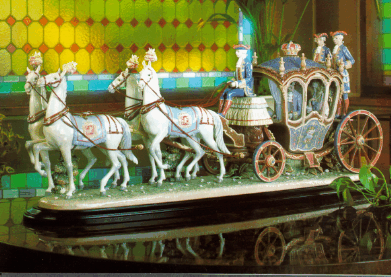
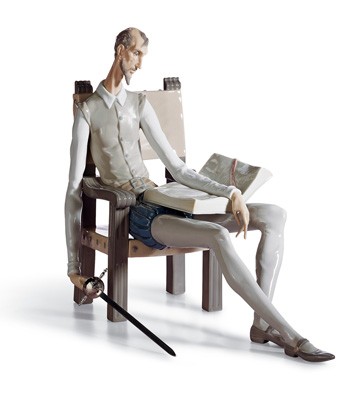
In 1992, Lladró was present in the Pavilion of Valencia, in the Universal Exhibition of Seville. In 1995, there was inaugurated the Center Lladró, in Madrid. In 1988, there was inaugurated the Museum and Gallery Lladró of New York.
The company has received the Prize “Prince Philip to the Managerial Excellence”, even in three occasions (1993, 1997 and 2002).
In 2003, the family Lladró decided to break the company. Three branches of the family, which were distributing the company, to 33 %, reached an agreement to distribute it. At the end of 2003, there was constituted a new board of directors, in whom each of three founding brothers was represented, by two of his children: Juan Lladró, by Rose and Angels Lladró Sala; Jose Lladró, by M ª Carmen and M ª Jose Lladró Castelló; and Vicente Lladró, by Juan Vicente and David Lladró Roig. In 2007, Juan Lladró assumes the property of the business, in its most, together with his daughters, Rosa and Ángeles.
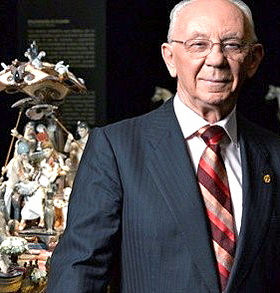
Juan Lladró (the new President)
All the pieces are elaborated, in the workshops of The City of the Porcelain, in Tavernes Blanques. The original piece is divided in fragments of which molds are obtained. These molds are refilled by liquid plasticene of porcelain, giving room to the parts, that are later recomposed, using plasticene of porcelain, as adherent. Different ornamental elements, as for example the flowers, are added later, by hand, on the recompound piece.

Later, the pieces are painted, by hand, and they are varnished. Finally, they are baken, during about twenty hours and, once exits of the oven, apply diverse processes of quality control to them.
I want to show you some figures, that I like very much. I have to say that all of them show a great tenderness, a great elegance and a great peace.
For example, I like this figure:
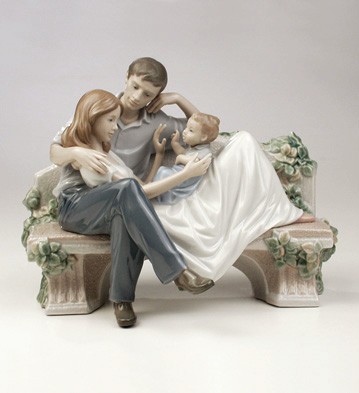
It represents Family. I like its joining together
And this complicity, among mother and daughter, is wonderful:

This is another nice figure:
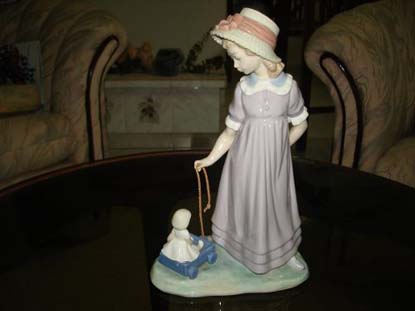
A funny scene:
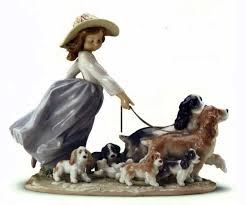
But the Lladró's most representative figure is the "Cinderella's carriage", which you can see, below, behind José Lladró:
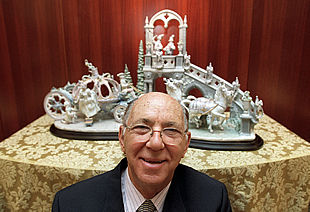
Well, now I hope that you can enter in a Lladró shop, like this one:

Until my next post, kind regards,
Luis.
Sponsored by Costaluz Lawyers.
Please click below:

 1
Like
Published at 11:47 AM Comments (1)
1
Like
Published at 11:47 AM Comments (1)
Spam post or Abuse? Please let us know
|
|